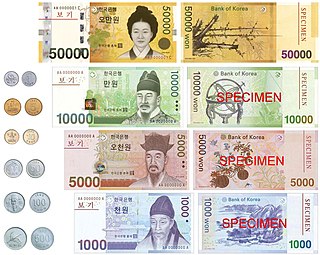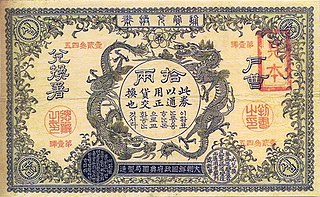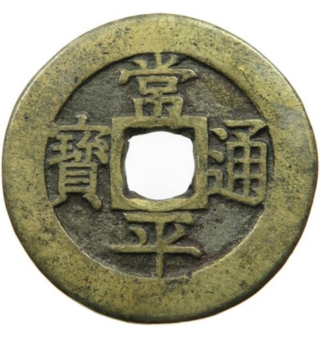
The yen is the official currency of Japan. It is the third-most traded currency in the foreign exchange market, after the United States dollar and the euro. It is also widely used as a third reserve currency after the US dollar and the euro.

The Korean Won or Korean Empire won, was the official currency of the Korean Empire between 1900 and 1910. It was subdivided into 100 jeon.
The Korean People's won, more commonly known as the North Korean won and sometimes known as the Democratic People's Republic of Korea won, is the official currency of North Korea. It is subdivided into 100 chon. The currency is issued by the Central Bank of the Democratic People's Republic of Korea, based in the North Korean capital city of Pyongyang.

The South Korean won is the official currency of South Korea. A single won is divided into 100 jeon, the monetary subunit. The jeon is no longer used for everyday transactions, and it appears only in foreign exchange rates. The currency is issued by the Bank of Korea, based in the capital city of Seoul.
The Hong Kong dollar is the official currency of the Hong Kong Special Administrative Region. It is subdivided into 100 cents or 1000 mils. The Hong Kong Monetary Authority is the monetary authority of Hong Kong and the Hong Kong dollar.
The New Taiwan dollar is the official currency of the Republic of China (Taiwan). The New Taiwan dollar has been the currency of the island of Taiwan since 1949, when it replaced the old Taiwan dollar, at a rate of 40,000 old dollars per one new dollar. The basic unit of the New Taiwan dollar is called a yuan (圓) and is subdivided into ten chiao (角), and into 100 fen (分) or cents, although in practice both chiao and fen are never actually used.

The Malaysian ringgit is the currency of Malaysia. It is divided into 100 sen. The ringgit is issued by the Central Bank of Malaysia.

The Taiwanese yen was the currency of Japanese Taiwan from 1895 to 1946. It was on a par with and circulated alongside the Japanese yen. The yen was subdivided into 100 sen (錢). It was replaced by the Old Taiwan dollar in 1946, which in turn was replaced by the New Taiwan dollar in 1949.
The yuan is the base unit of a number of former and present-day currencies in Chinese.

The hwan (Korean: 환) was the currency of South Korea between February 15, 1953, and June 9, 1962. It succeeded the first South Korean won and preceded the second South Korean won.

The yen was the currency of Japanese Korea between 1910 and 1945. It was equivalent to the Japanese yen and consisted of Japanese currency and banknotes issued specifically for Korea. The yen was subdivided into 100 sen. It replaced the Korean won at par and was replaced by the South Korean won and the North Korean won at par.

The yang (양/兩) was the currency of the Korean states Joseon and the Korean Empire between 1892 and 1902. It was subdivided into 10 jeon (전/錢) or 100 bun (분/分); and 5 yang = 1 hwan (환/圜).

The mun was introduced as the main currency of Korea in 1625 and stayed in use until 1892. Prior to the mun, cash coins with the inscriptions tongbo (通寶) and jungbo (重寶) and silver vases called ŭnbyŏng were used as currency in the Goryeo Dynasty (918–1392), as well as imported Chinese currency. The mun resembled and was derived from the Chinese wén. Coins denominated in mun were cast in copper-alloys such as brass or bronze and were round with square holes. From the 17th century until the end of the 19th century, coins denominated in mun bearing the inscription Sangpyeong Tongbo, introduced in 1633, were the most widely circulated currency. In 1888, coins were struck in small numbers denominated in mun and won. The mun was replaced in 1892 when the yang was introduced.
The won is the currency of both North and South Korea. "Won" is a cognate of the Chinese currency unit, the yuan, and the Japanese currency unit, the yen, meaning "round object". The won is subdivided into 100 jeon.

The Bank of Joseon (Korean: 조선은행) or Bank of Chōsen was the central bank of Colonial Korea, and later of South Korea. The bank issued the Korean yen from 1910 to 1945 and the won from 1945 to 1950.
Japanese currency has a history covering the period from the 8th century AD to the present. After the traditional usage of rice as a currency medium, Japan adopted currency systems and designs from China before developing a separate system of its own.

Korean currency dates back as far as the Goryeo dynasty (918–1392) when the first coins were minted. The coins, cast in both bronze and iron, were called tongbo and jungbo. Additionally, silver vases called ŭnbyŏng were widely used and circulated as a currency among the aristocracy of Goryeo.

The Dangbaekjeon refers to a series of cash coins that were used during late Joseon period of Korean history, it was first issued in November of the year 1866 by the order of Heungseon Daewongun.

The paper money of the Qing dynasty was periodically used alongside a bimetallic coinage system of copper-alloy cash coins and silver sycees; paper money was used during different periods of Chinese history under the Qing dynasty, having acquired experiences from the prior Song, Jin, Yuan, and Ming dynasties which adopted paper money but where uncontrolled printing led to hyperinflation. During the youngest days of the Qing dynasty paper money was used but this was quickly abolished as the government sought not to repeat history for a fourth time; however, under the reign of the Xianfeng Emperor, due to several large wars and rebellions, the Qing government was forced to issue paper money again.
Japanese military currency (日本軍用手票) is the name given to money used by the Japanese armed forces for the purchase of supplies in occupied territories. It was mainly issued in denominations of yen, and subsidiary currency of sen with the exception of the first Sino-Japanese War series. This particular article covers pre-Shōwa era currency issued from 1894 to 1918 in three different periods. During this time Japan was militarily involved in the First Sino-Japanese War, Russo-Japanese War, and events during World War I such as the Siberian intervention. The military currency issued during these events circulated in Japanese Korea, the Republic of China (Manchuria), and the Russian State. All of the notes issued share a similar design which resembles government issued civilian currency which circulated in Japan from 1872 to 1899. Japanese military currency was exchangeable at the given time for both silver and gold bullion. Most of these events were not long term which impacted the amount of surviving currency in different ways. It was also routine after each event for officials to exchange the military currency issued for bullion or other forms of payment such as banknotes. Unredeemed notes were thus either held by the public as commemorates or eventually lost in the decades that followed. Those that remain today are collected and traded depending on the condition and surviving rate of the series.
















